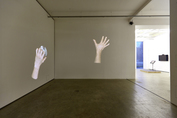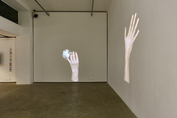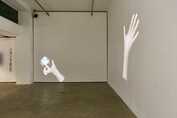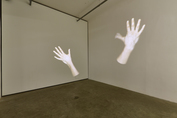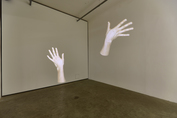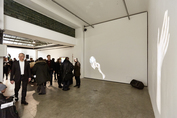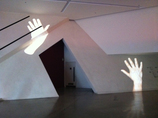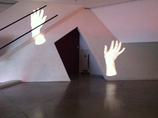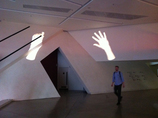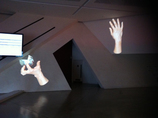Dynamic projection
Dimensions variable
Computer-controlled mirror, media player, 2 projections, 2 videos, speakers
Assistance: Patricia Köstring
Assistance camera: Azalea Ortega, Nikita Zhukovskiy
Postproduction: Alexandre St-Onge
Performers (hand-acting): Marie-Claude Poulin, Nikita Zhukovskiy
A hand moves, it explores its surroundings, traces the surface on which it lies, it acts.
Based on this actually simple cinematographic process, in Topography of Movement conventional perspectives of the two-dimensional (the motion picture) and the three-dimensional (the real environment) are altered. The relationship between image projection and screen changes, the space is reconstructed by the cinematic sequence. The original sound of the hands traversing a surface, recorded during filming, supports a supposed authenticity of the action.
For her dynamic image projections, Ruth Schnell works mostly with computerized projection mirrors. The image content itself is cut-out and projected without a background. It moves about in manifold ways. The projected hands perform an activity; the sequence in turn is dynamised, accelerated or counteracted via the movements of the projection mirror, depending on how the two movement patterns come together.
Digital image production and a spatial reference system intertwine via these overlapping movements. The real space with the help of the moving projection is newly modeled because, depending on the projection angle and surface structure, distortions and fragmentations of the image content arise in the contrast between projection and architecture.
The multiple projection (a right and a left hand), the scaling of the projected scene, as well as the implied tilt of the camera angle from top view to a side view override conventions of spatial order. If the left or right hand points to an absent body, a subjective viewer perspective is made impossible by the high magnification of the image content. At the same time the viewer identifies sensorially with the represented hands that perambulate through the space, as if they were touching and feeling the surface of the walls and ceilings present in the same physical space of the viewer. The viewer is transported to the action of the video, embodying the represented hands, experiencing the space sensorially.
Exhibitions:
2016, A Model for the Aesthetics of Digital Art, City University of Hong Kong, Hong Kong (CHN)
2016, Digital Synesthesia, Angewandte Interdisciplinary Lab (AIL), Vienna (AT)
Bibliography:
Gsöllpointner, K., Schnell, R., Schuler, R. K. (eds.): Digital Synesthesia. A Model for the Aesthetics of Digital Art, Edition Angewandte, Walter de Gruyter, Berlin / Boston 2016 Images
Images
